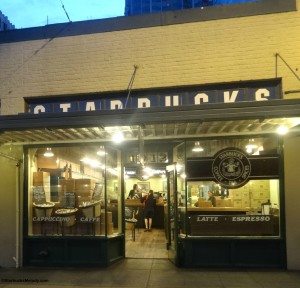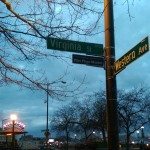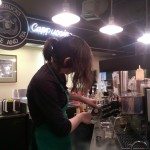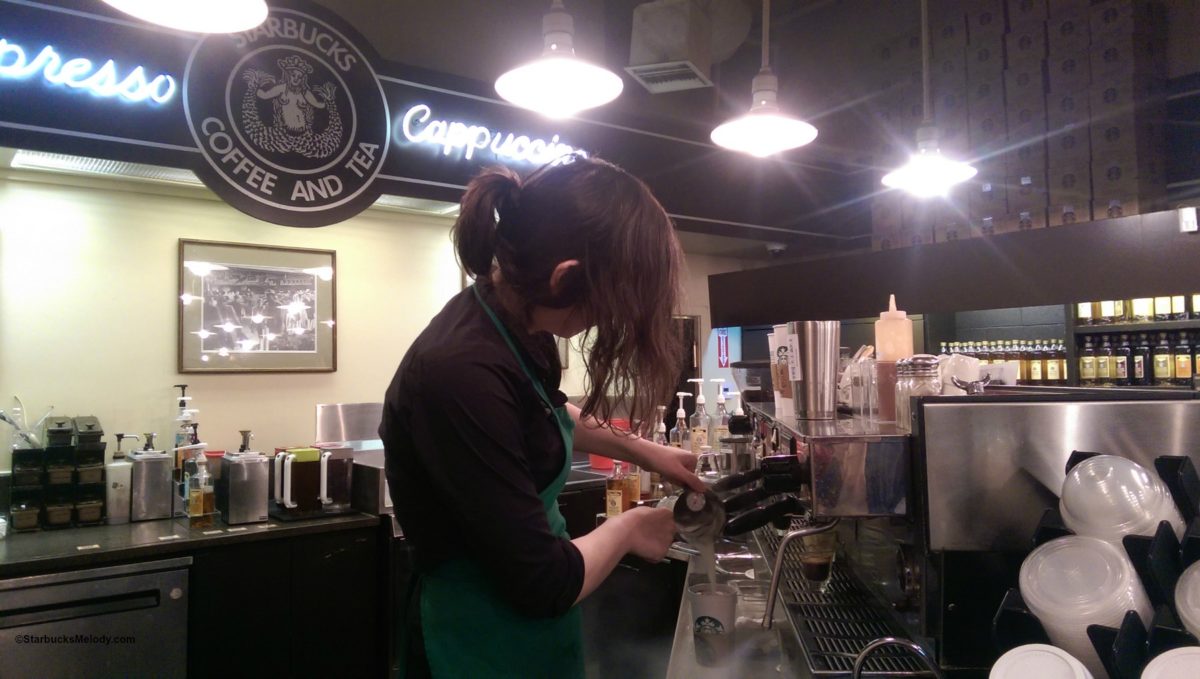 I know that many people don’t know much about the history of Starbucks, other than it began in Seattle’s Pike Place Market in 1971. Let’s dive into that old history in more detail:
I know that many people don’t know much about the history of Starbucks, other than it began in Seattle’s Pike Place Market in 1971. Let’s dive into that old history in more detail:
The three original founders of Starbucks were Jerry Baldwin, Zev Siegl, and Gordon Bowker, and that original first Starbucks was located at 2000 Western Avenue. Its grand opening date is in dispute, but usually thought of as March 30, 1971. Click here for a glimpse of the original building (no longer exists – later demolished). I’ve also heard April 1, 1971 as the opening date. It could be that both of these dates have an element of truth to them. Wikipedia says March 30, 1971, and every old Seattle Times article will state that Starbucks opened in March 1971. Media relations at the Starbucks headquarters says that it’s April 1st – the day that the lease was signed. It could be that the store was open for business a few days before the actual lease signing. In 1971, Seattle was on the decline. It was one of the few years that Seattle lost some of its population, due to massive Boeing layoffs. Given the unusual economics of what Seattle looked like 1971, it is realistic to think that the building owner let the three founders work on the building and open a business before actually even signing a lease! It took them two months to convert what was once a junk shop into Starbucks Coffee Tea and Spices.
The three men had some debate as to what to call the business. It was nearly called Pequod or Cargo House. The name Starbucks comes from the book Moby Dick, as Starbuck was the first mate on the ship the Pequod.
In 1971, Starbucks sold 21 varieties of tea including Lapsung Souchoung Keemun, Young Hyson, Russian Caravan, Gunpowder Dragonwell, and more. The original coffee offerings in 1971 included Sumatra, Kenya, Uganda, Colombian, Mexican Java, New Guinea, Mocha Java, French Roast, Brazil, Yukon Blend, Peet’s Blend, and Major Dickenson’s Blend.
Jerry Baldwin learned to roast coffee from Alfred Peet, the founder of Peet’s Coffee and Tea – for Starbucks’ first year of business, it purchased coffee directly from Peet’s.
In June 1971, a pound of Sumatra at Starbucks would have been a pricey $1.75.
Starbucks grew very slowly. The second store, in Seattle’s University Village, opened in November 1972.
One absolutely key thing to remember about Starbucks is that it opened before there were official boundaries designating the Pike Place Market historical district. In 1971, it’s likely that anybody would have said that Starbucks sat inside the loose boundaries “Pike Place Market”. However, in 1971, there was a movement among Seattleites to demolish the entire Pike Place Market and create new construction. The boundaries of the historical district – creating a small area where buildings cannot be demolished – were established in November 1971, by the Pike Place Referendum (more officially called Initiative number 1) on the ballot. 62% of Seattleites chose to save Pike Place Market and establish the historical boundaries.
Today, as you visit Seattle’s Pike Place Market, you’ll see brown signs (hanging near street signs) designating the boundaries of the historical region.
you visit Seattle’s Pike Place Market, you’ll see brown signs (hanging near street signs) designating the boundaries of the historical region.
In November 1971, Starbucks found themselves located just outside of the newly-defined Pike Place Market historical district. In fact, they were literally about one half a block away from the new Pike Place Market boundaries, if that. The closest current structure to the original Starbucks is the Tom Douglas restaurant Seatown at the corner of Virginia and Western. Virginia and Western is one of the boundaries. Starbucks was outside the lines of the newly-formed Market by such a tiny distance. Seatown is at 2010 Western Avenue.
As you recall, Starbucks opened up precisely at a time when people were leaving the city, and Boeing had laid off thousands. In April 1971, a billboard hung in Seattle with the words “Will the last person leaving Seattle turn out the lights?” However, over time, Seattle did recover from the recession of 1971. The original Starbucks met its fate when the building was slated to be demolished. Forced to move, Starbucks relocated to a convenient spot within the newly-formed Pike Place historical district: 1912 Pike Place. In January 1977, Starbucks moved their first store a few hundred feet. Ultimately, 2000 Western Avenue was demolished and construction of a low-rise building with condominiums and retail on the bottom began – that building was completed in 1982 and still stands at that north corner of Pike Place Market, currently the home of the above-mentioned Tom Douglas restaurants.
 Today when you visit the 1912 Pike Place Starbucks, you can order a handcrafted beverage made by skilled baristas on a La Marzocco espresso machine. Starbucks first started serving espresso drinks in April 1984, at the corner of Fourth and Spring in downtown Seattle. Today we would hardly be able to imagine a Starbucks that didn’t have any kind of espresso machine!
Today when you visit the 1912 Pike Place Starbucks, you can order a handcrafted beverage made by skilled baristas on a La Marzocco espresso machine. Starbucks first started serving espresso drinks in April 1984, at the corner of Fourth and Spring in downtown Seattle. Today we would hardly be able to imagine a Starbucks that didn’t have any kind of espresso machine!
The fifth Starbucks opened in late April 1982, located in Seattle’s University District at 4555 University Way NE. So when Howard Schultz joined Starbucks as an employee in September 1982, there were five Starbucks stores total.
The first five Starbucks were as follows: 1912 Pike Place (March 1971, relocated in 1977), University Village Starbucks, a store in Bellevue, Washington (a nearby city), the classic Capitol Hill Starbucks in Seattle at Broadway and Republican (opened originally at 507 Broadway East and later relocated), and finally, the store at 4555 University Way NE (April 1982).
Hope you enjoyed your early Starbucks years history lesson!
Sources:
- Seattle Times historical archives, “A new source for that heady aroma,” June 17, 1971, page 17, B section – Lists original teas and coffee, and mentions the conversion of a junk shop into Starbucks. Gives opening of Starbucks as “March 1971.”
- Seattle Times historical archives, November 29, 1972, page 29 – announces the new Starbucks in University Village.
- Seattle Times historical archives, April 29, 1982, page 83 – announces the new 507 Broadway Starbucks.
- Seattle Times, Melissa Allison interview of Gordon Bowker, March 9, 2008 – Gordon Bowker tells Melissa Allison, Starbucks came “dangerously close” to being called “Cargo House.”
- Seattle Times historical archives, November 3, 1971, page 24, “Pike Market vote called ‘Victory of People'”
- Howard Schultz’s start date: September 1982 – off-the-record conversation with partners.
- April 1, 1971, opening date as the date the leased signed – off-the-record conversation with partners.
- Pour Your Heart Into It, Howard Schultz and Dori Yang:
- – First espresso bar – pages 58 – 59
- – Discussion of recession of 1971 and billboard – page 31
- – Nearly named “Pequod” – pages 32 – 33
Related posts
17 Comments
Leave a Reply Cancel reply
You must be logged in to post a comment.
Sponsors
Recent Comments
- DEVIN on Compostable Straws Land in Seattle Starbucks Stores
- coffeebeanz on Why do you go to Starbucks less often? (If that’s true for you)
- Willi on You can now buy a Siren statue: $6,000
- Willi on A major revamp of your drink recipe: Testing syrup extracts and cane sugar
- Skip on Why do you go to Starbucks less often? (If that’s true for you)







Thank you for this awesome post. The history of Starbucks is always a pleasure to read.
So many times I randomly quiz my fellow partners of where the name came from and when it was first opened. And dare I say it, I ask Who is Howard Schultz? Yep my heart breaks sometimes.
Brilliant article. Really interesting. I’m looking forward to your next book.
Love this early glimpse into the history of Starbucks. Can’t wait to learn more!
I feel like there have been many times that I’d read your entries via the email notifications received & would never make it to comment online. But, I DO love reading your entries, Mel!
Thank you so much for this history of SBUX. You make it so easy & interesting for me to read & follow. I certainly know more, today, than I’d known before about this mystical company that I LOVE! 😀
That last image of the partner in front of the La Marzocco, it’s certainly very nostalgic to see-brought me back some fond memories. (; It also reminded me of how we used to call out the drink order from register-person to bar & the bar person would verbally acknowledge & write the cup there & make it (I believe 1912 still does it this way, right?)
I dunno how ya do it, Mel! (and well!) I admire your consistent SBUX passion that you eloquently share on each entry. I always learn new things! Thank you, Mel!
Thanks for this post. As a Seattle/Eastsider living in Florida, I’m often asked about Starbucks history. One of the most frequent corrections I have to make is that the Pike Place Starbucks is not the “original” Starbucks. It is such a common belief that I was beginning to think my memory was wrong. Thanks for reminding me that I am not crazy.
I appreciate all these comments! Please share this post if you like it.
The Starbucks “history lessons” articles are some of my all time favorite articles, and so it makes it worth all the effort of digging around for old information when someone else likes that kind of thing too.
@Sheila – That’s funny you should say that.I know many partners who really don’t know that 1912 Pike Place is a relocated store. After a while, it is easy to question your own knowledge!
So cool. Thanks for the history lesson!
i wondered when you would write about the ‘original’ starbucks 🙂
also, never knew that tiny store at broadway and republican was one of the first few stores! that was ‘my’ starbucks when i lived up there, until 15th ave and roy st came along.
@Elly – Thanks – This is one of my favorite articles in a while! It actually developed out of research for the book. 🙂
a quick memento, as well:
way back when, when i was going through starbucks training for my new store (which is so old now!), our trainer asked us where the name starbucks came from. no one else in the room knew, except for bookish little me. the trainer was amazed, because normally *no one* could answer the question.
we think people don’t read enough /now/. this was back in…1997?
i recently joined a book club (aptly called ‘drinking on weekdays’), and the first book they all read was moby dick. made me laugh 🙂
Hey, Melody! I’m making my Starbucks pilgrimage to Seattle this coming January. Would love to meet up for a cup of coffee.
Hi my dear friend Melody.. Its been a long time I had ny first comment about the Yukon
..just to add up and I guess to complete the history of Starbucks Pike Place. When Starbucks fully established the store and always experiencing a customers build up and have nothing to do but to serve their Latte as quick as possible. There was a blind performer named Jeane Town who serenades customers in line while waiting for their drinks to be served. And then they found that it is something that will help them to entertain and complete the coffeehouse experience of the customers. So now that’s how coffeehouse music started in Starbucks .. I hope this comment will help in addition.
Thanks,
Arc Soleria/8159
Global Coffee Master
Starbucks Ph
Sorry for any typo
[…] “Steeler is a regular customer at the first Starbucks!“ […]
I wish there was more information and pictures on the pre-Schultz Starbucks. Somebody could write and publish a successful book on this subject.
@Morris – I appreciate your comment. This article was actually born out of the idea/ research that I was doing to write a 2nd book about Starbucks. I self-published a first book which was mainly my cute, funny, or sad Starbucks stories, and written half in a serious tone of voice and at times in a very silly tone of voice.
I hoped to write a much more serious second book, with a significant segment on Starbucks history.
Like you, I’m very interested in what happened to Starbucks pre-Howard Schultz era.
I spent time in newspaper historical archives and what I found is that pre about 1995, Starbucks was barely newsworthy. It was about the mid-1990s that the world started paying attention to Starbucks.
The whole era from 1971 to 1982 is essentially Starbucks as a small business. So small that it was blip on the radar of Seattle, so not well documented or anything.
I did a couple of interviews in conjunction with writing book #2.
http://starbucksmelody.com/2015/09/17/tbt-the-starbucks-freshly-roasted-coffee-delivery-truck/
^ That ancient history kind of gives you an idea of what I dug up. But again it shows a very informal, small business. “Go buy a truck!” with almost no instruction to a young Starbucks employee…
The 3 people who would know the most about that 1971 to 1982 era of Starbucks would be Jerry Baldwin, Gordon Bowker, and Zev Siegl. Of course, they don’t know me. I don’t know how to reach them. I believe it *might* be possible to find Jerry Baldwin through Peet’s still, but I don’t know, and I’m not going to randomly try to find him, unless I were to get much, much, closer to a finished book.
I’ve thought about doing an article which is just a call out to readers looking for Starbucks stories, but I didn’t have much luck when trying that once before a long time ago.
This website is small, in the big scheme of things.
I’m open to ideas….
You have a lot of sources to draw upon in the Seattle area. Many of the people who worked in the Starbucks store during the 70’s are likely still alive and could provide you with a considerable amount of detail on the operations of the early Starbucks. Some of these early employees may have pictures stashed away of themselves at work. #2 Zev must be reasonably available because somebody I know very well met him at an event in Seattle this year and asked to take him for lunch and he graciously accepted. The other two co-founders may avail themselves as well if you track them down and ask. Zev may be able to point you to people. #3 There are hundreds of people in Seattle who were customers of Starbucks during the 1970’s. I’ve spoken to a few of these early customer about the early history of Starbuck. #4 If you work for Starbucks, somebody may have an archive of materials they have collected that they may grant you access to. #5 There were other coffee shops in Seattle during the 1970’s in the U District – a few of those owners I’m sure were well aware of Starbucks and could give you some insights. #6 Pike Place market may have some records. #7 Seattle library – maybe a librarian can help you find some interesting material. It would be fascinating to know what the revenues were for the first 12 years of Starbucks by year. #8 There is a small possibility that Howard himself would make himself available for an interview if asked. At a minimum, you could write out some questions and see if he would answer them. I really hope that you follow through on this book idea.
As an aside, there is an interesting parallel between Ray Kroc/McDonald’s and Howard and Starbucks. Ray Kroc went to visit the McDonald brothers in Southern California because he sold milk shake mixers and he couldn’t understand the first McDonalds needed 8 milk shake machines with five spindles each.